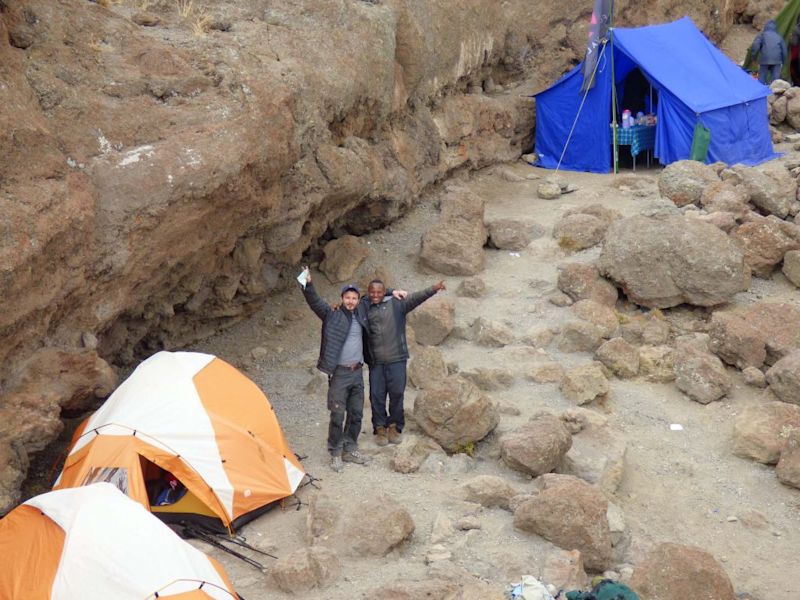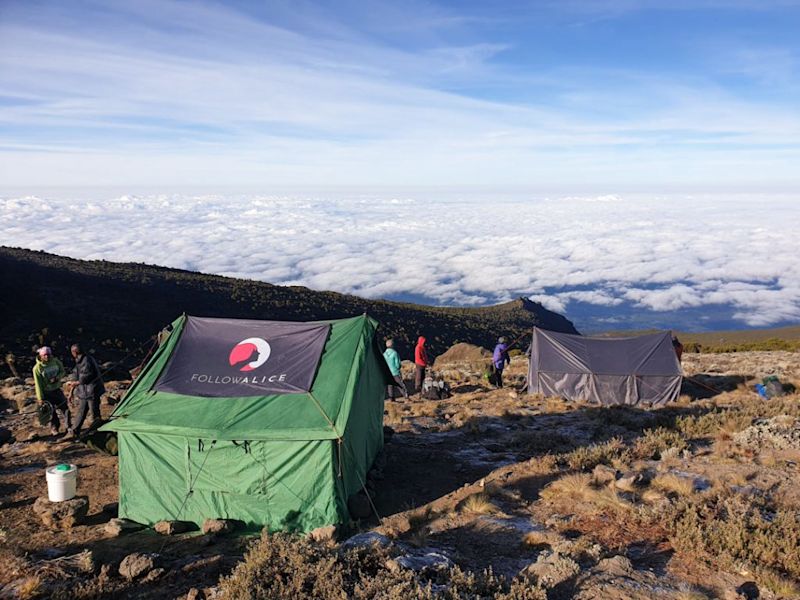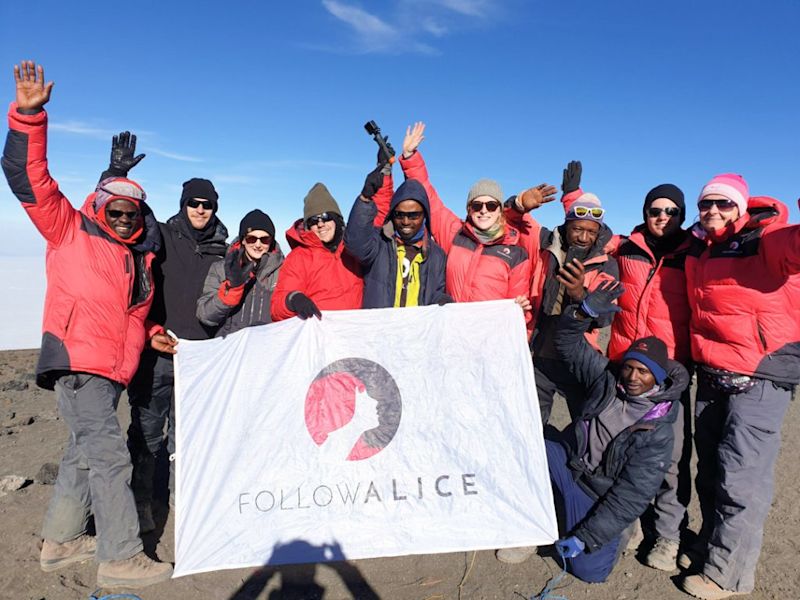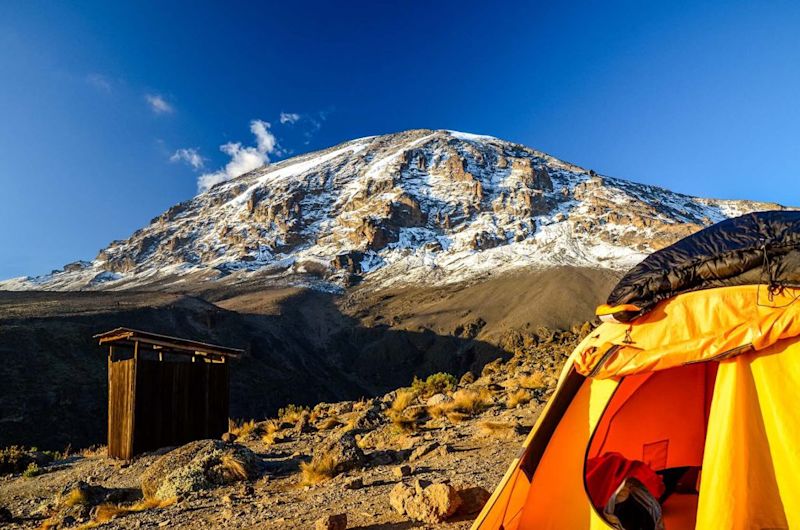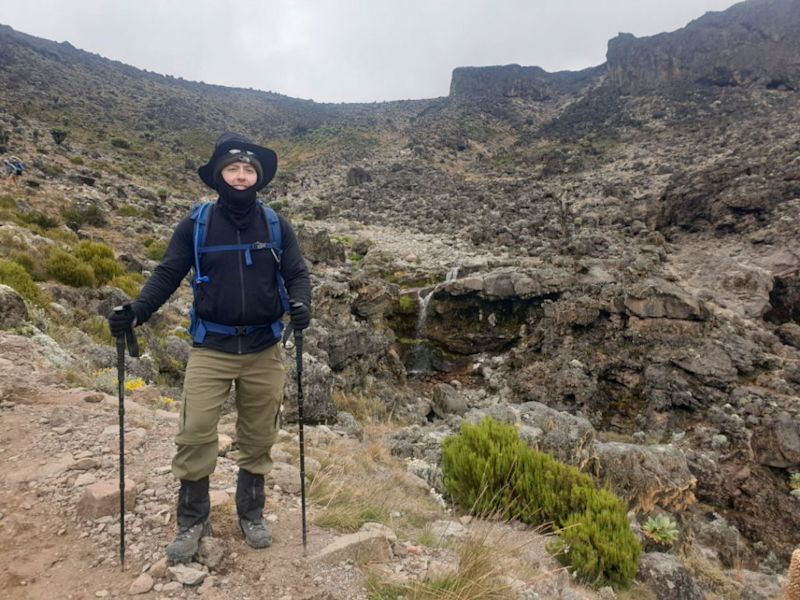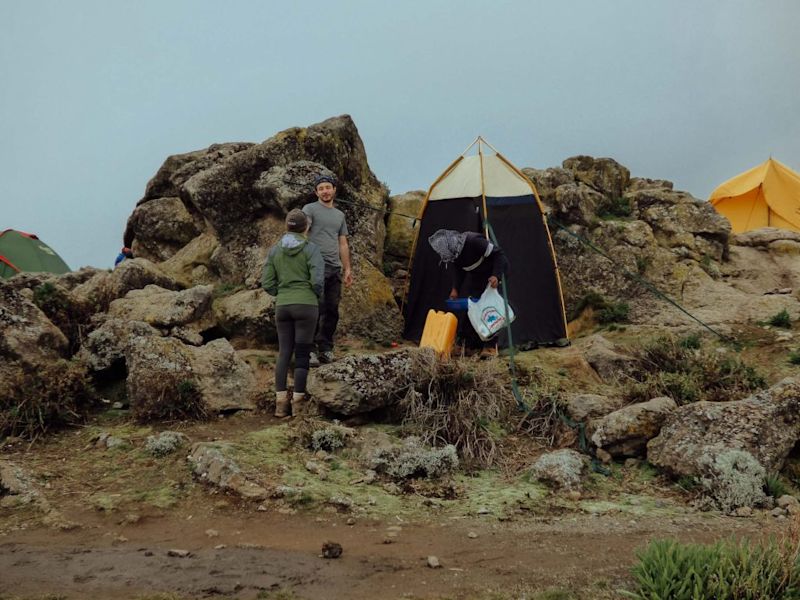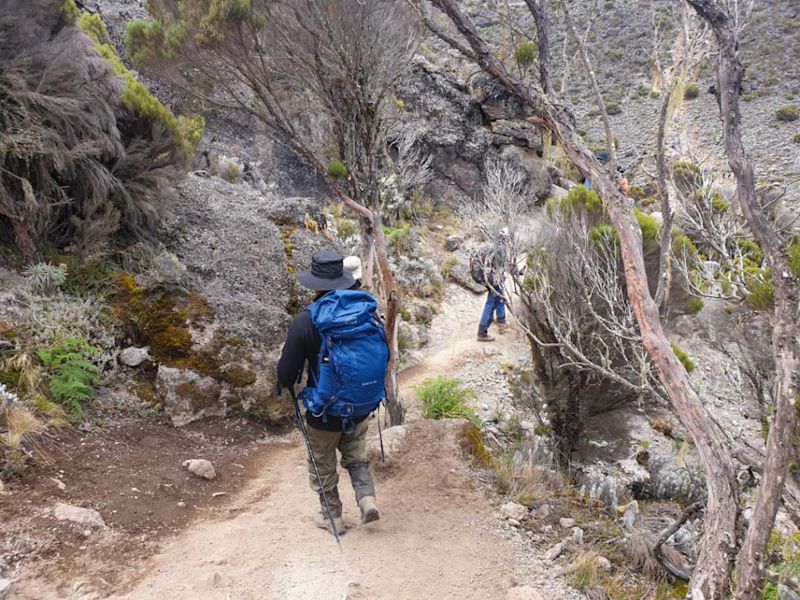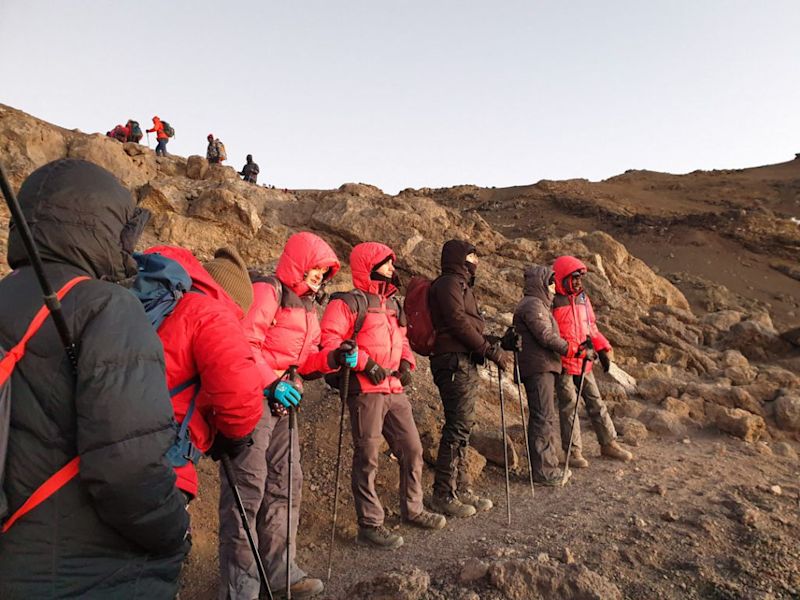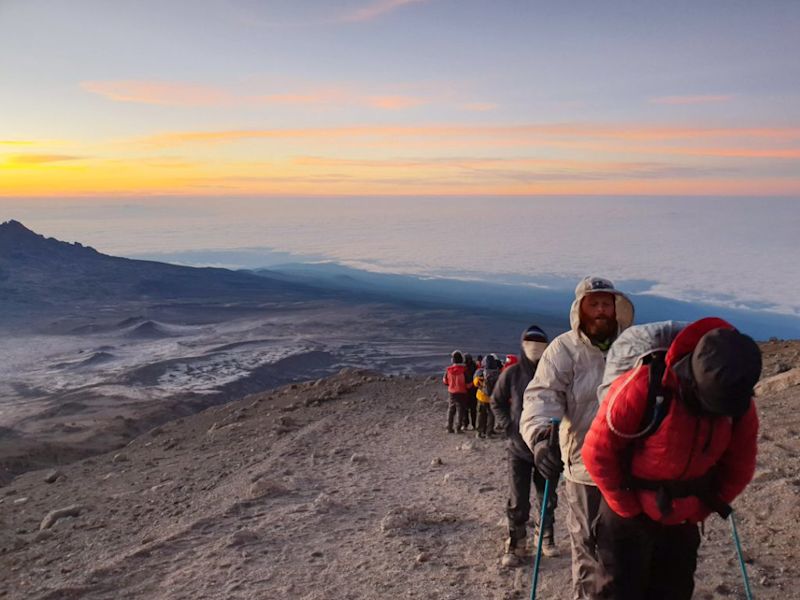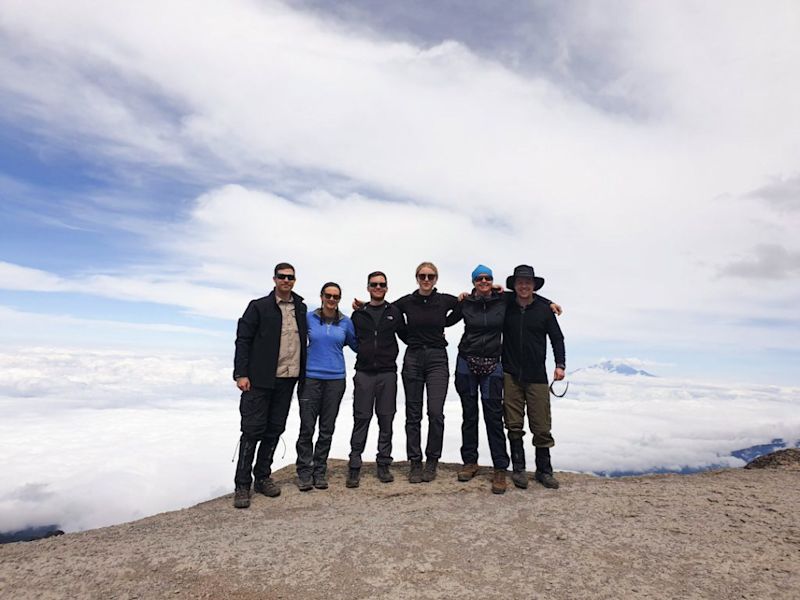Recently I posted my Kilimanjaro journal, in which I shared my experiences trekking the seven-day Lemosho route. I did this to share with others what to expect on (and of) the mountain.
Now I want to address a few things – both small and large – that I wish I knew before climbing Kilimanjaro. Interestingly, some of these were things I actually already knew about, but hadn’t anticipated to be as intense as they were! From lips that become painfully cracked to getting into an unnecessarily chilly sleeping bag, please feel free to learn off of me. 🙂
Fresh-faced and excited to have reached our first night's stop!
1. Every single camp is cold
I expected the camps high up on Kilimanjaro to be cold, even icy, but what I didn’t really appreciate was just how cold every single camp would be! Even our very first camp, which was in the rainforest zone near the base of the mountain, was really cold. This camp sits at 2,895 m (9,498 ft) above sea level, so it actually makes sense that it won’t be too balmy at night, but I was still surprised.
Further adding to the wrong expectation is the fact that you often trek the rainforest section of Kilimanjaro in a T-shirt and shorts, and temperatures can be very hot (and humid) during the day. When the sun sets, however, even the lower camps become frigid, and you want to cosy up in your thermal sleeping bag!
To prepare properly for the varying weather conditions on Kilimanjaro, we recommend reading our Kilimanjaro packing list or simply watching our Kilimanjaro packing list video.
Hot tip (pun intended): If you bring along a hot water bottle, your crew will fill it for you before bedtime!
2. You find it hard to sleep
You’re super tired at the end of each day's trekking on Kilimanjaro. So you might naturally assume that you’ll snuggle into your sleeping bag and be asleep in moments. But actually, falling asleep at high altitude can be tricky. The reduced oxygen at high altitude often impacts on sleep in various ways, from insomnia to restlessness, interrupted sleep and vivid dreams.
It’s best to be prepared for this happening, so that you don’t stress and are also mentally prepared it.
Climbing into your cosy two-sleeper tent at the end of a long day of trekking is just bliss!
Avoid sleeping pills
Some people might think to battle the sleeplessness associated with altitude by taking sleeping pills. But sleeping pills suppress your respiratory system. This is not something you want to do on Kilimanjaro, where the air is already pretty thin. So while it can be difficult at times to sleep on Kilimanjaro, please don’t be tempted to take sleeping pills. Rather, try to accept it as part of the experience.
You might like to learn more in Sleeping on Kilimanjaro.
The higher up you climb on Kilimanjaro, the trickier sleep becomes
3. Your skin and lips take a beating
I’ve never really been one to pay attention to my lips, especially when it comes to protecting them against the weather. In fact, I don’t think I’ve ever before used a balm with an SPF factor. And prior to Kilimanjaro I definitely hadn't ever thought about protecting them from the wind. But wow, the need to protect them – and you skin – when you climb Kilimanjaro is something that I’ll now be telling everyone about!
The importance of protecting your lips
The cold and strong winds on summit day ruined my lips. I didn’t notice the beating they were getting at the time, but the next day my lips were super swollen, and they actually felt quite numb. Over the ensuing days they peeled and cracked, and were very painful. And when I tried to smile … ouch! I looked like a character out of Wallace and Gromit.
The pain could have been very easily avoided if I’d just bothered to protect my lips properly. So I would advise those preparing to climb Kilimanjaro to regularly apply an SPF lip balm during the trek. And then on summit day, when you're exposed to the fiercest cold and wind, cover your mouth with your balaclava. Trust me, you won’t regret it!
Top tip: Regularly apply SPF lip balm on summit day to prevent painful lips the next day.
Look after your skin
Your skin gets pretty dry on Kilimanjaro – some folks' skin more than others, of course. This is a result of the cold and dry weather conditions high up on the mountain. So be sure to bring along some heavy-duty moisturiser. Your hands and face especially need the extra moisture, as they’re the bits you’re able to give a good soapy scrub during ‘washy washy’, and also because they’re the most exposed parts of your body.
Don't celebrate your Kilimanjaro victory with cracked lips and dry skin the next day – celebrate it only with stiff muscles 😉
4. You need to pee all the time
Kilimanjaro trekkers should be drinking at least three litres of water a day. This is to keep you adequately hydrated as well as prevent (and also alleviate) the symptoms of altitude sickness.
I’m generally pretty bad at drinking water – I don’t drink enough. So I thought the three-litre quota might be quite a task for me. I was, however, pleasantly surprised. The first couple of days of the trek (when you’re lower down in the rainforest and therefore in a warmer climate), I was drinking constantly. I actually drank all of the water in my CamelBak and had to move on to the water in my water bottle. Great! However, all this drinking meant an untold number of loo breaks ...
In addition to all the hydrating going on on the mountain, one of the side effects of high altitude (yes, yet another one!) is that you need to wee a lot more than usual. Combine the two and you simply need to pee all the time.
Toilet tents and rock toilets
On Kilimanjaro, you either pee at camp or behind a rock when on the trail. Camp is the nicer of the options for a loo stop, as there are toilets. Also, your tour operator should provide a private toilet tent, which is even nicer than the public ones, as they're cleaner. (If you're trekking the Marangu route, however, there's no camping – you stay in huts and use communal ablution facilities.)
But while camp is the nicer place for going to the loo, there's no way you can go the entire day without having to take a leak on the trail. In such situations, you simply find a rock or bush to duck behind.
A 'public' toilet sits in shadow on Kilimanjaro
Advice for women
Ladies, you might like to consider including a urinating device like a Shewee in your Kilimanjaro packing list. These allow you to urinate standing up. They also mean you only have to unzip your pants, not drop them, which is a blessing when it's icy cold and the less flesh exposed, the better! We discuss such matters in detail in Advice for women climbing Kilimanjaro.
Leave no trace
Kilimanjaro National Park has a ‘leave no trace’ policy. This requires tour operators to carry all waste down from the mountain. And they can get in trouble if they don't.
As for us as trekkers, our part in leaving no trace means not leaving any toilet paper behind on the trail. Not even buried. You're required to carry your waste to camp, where you can put it in the bin, so be sure to pack little bags for this purpose.
It doesn't take the sound of a waterfall to make you need to wee on Kilimanjaro – higher up, you need to go ALL the time!!
Visit the toilet tent just before heading to bed
During my trek I regularly found that as soon as I'd climbed into my sleeping bag (and had started to get cosy) that I would then need to pee really badly. Under usual circumstances this would be a quick hop and a skip to the toilet in my PJs, however, on the mountain, it’s a real procedure. This is especially true as you get higher up and the lack of oxygen makes you out of breath from the smallest of tasks. And venturing back out into the frigid air – bleh! Save yourself the trauma and go to the toilet before you get all snuggled up in your bag!
Top tip: Always go to the toilet before heading to bed, even if you don’t feel like it’s needed.
The Follow Alice toilet tent on Kilimanjaro – it's nicer and cleaner than the public toilet 🙂
5. The water in your hydration pack freezes on summit day
Prior to this trip I had never used a hydration pack before. To be completely honest, I thought they were an invention for lazy people who weren’t satisfied with the perfectly adequate H2O solution that is the water bottle. HOW WRONG I WAS!
I can safely say that my hydration pack (I used a CamelBak) was one of my most prized pieces of equipment on the entire trip. I honestly believe that my experience would've been very different (read: worse) without it. Why? Two main reasons ...
- My CamelBak holds three litres of water. This is the recommended amount of water that you should drink per day (at least). Having it stored all in one place meant that I could easily monitor how much I was drinking in a day. I also didn’t need to fuss with multiple water bottles.
- It’s so convenient. I could drink water whilst walking – no slipping my backpack down an arm to find my bottle, or asking a friend to retrieve it for me. I’m also pretty sure I would’ve drunk a lot less water if I’d just had water bottles given the extra hassle. The easy accessibility of the hose and its mouthpiece makes you so much more inclined to take a sip or two of water whenever the thought pops into your head.
When your hydration pack freezes
The only downside of the hydration pack is that when the temperature drops below freezing, your water turns to ice. First of all, the water in the hose freezes, and then the water inside the pack freezes too. Nothing like carrying a bunch of ice that does nothing to quench your thirst! And sometimes (in rare cases) the freezing process can also cause the mouthpiece of your hose to break.
On Kilimanjaro, the water-in-your-hydration-pack-freezing-over scenario is only something to consider on summit day. It's not cold enough on the other days for the water in your pack to freeze. But on summit day, your water doesn't stand a chance, as you not only begin your trek at midnight, but you also climb into an arctic zone. Double whammy!
On summit day, you therefore have to turn to rely on your water bottle.
Many backpacks these days have hydration packs built into them
How to carry your water bottle on summit night
As discussed in our Kilimanjaro packing list, on summit day you need to place a full one-litre water bottle in a thermal sock deep inside of your daypack. If you carry the bottle in your jacket or daypack pocket, the water will freeze.
As well as keeping the bottle inside of your bag, you need to ensure it’s firmly fastened and kept upside down. The reason for placing it upside down is that water freezes from the top down. In this way, even if the cold starts to get to your water bottle (which it might), the water at the end of the bottle that you want to drink from won’t be frozen.
Top tip: On summit day, keep your water bottle in a thermal sock inside of your bag, as this keeps the water from freezing.
Look at how we're all bundled up – little wonder the water in hydration packs freezes on summit day!
6. You feel ‘off’ when high up the mountain
I knew before heading to climb Kilimanjaro that it’s common to experience some high altitude symptoms like headaches or nausea. But I didn’t expect to feel iffy for such a consistently long time. Basically, you just don’t feel optimal when high up the mountain.
For each person the point at which the altitude starts to affect you is different, and your symptoms can of course vary. Generally speaking, you can start to feel the effects of altitude from 3,000 m above sea level.
So much of Kilimanjaro is mental – believing in yourself and pushing through when you're not feeling your best
Feeling iffy versus altitude sickness on Kilimanjaro
Altitude sickness is a serious illness that can require you to quickly descend the mountain in order to recover. But feeling a bit off because of high altitude is another thing – it isn't serious and you can push through it. Knowing the difference is the job of your trek guides. This is why it's so important for you to speak with your trek guide about how you're feeling.
Always be open and communicate with your guides about how you’re feeling. They're there to look after you, and are trained to know the difference between symptoms of high altitude and symptoms of actual altitude sickness.
Always, always let your trek guides know how you're feeling – it's their job to monitor your health.
Prepare yourself mentally
The best piece of advice in relation to feeling yucky high up on the mountain is to prepare yourself for feeling this way. It’s inevitable that you will feel something, whether it’s a headache or slight nausea or whatever. If you go knowing that this is likely to happen, and that it’s totally normal, you won’t feel alarmed when it happens. And hopefully you’ll have already determined to power through it.
Note too that the smallest of activities – things that you wouldn’t think twice about on a normal day – can be pretty exhausting at altitude. Getting in or out of your tent, for example, can prove a real effort because of the diminished oxygen in the air. So just be sure to take things slowly – rush is unnecessary!
Top tip: Prepare yourself mentally before the climb that you won't feel your best near the summit.
It's common to feel a bit iffy high up on Kilimanjaro, as the reduced oxygen takes a toll on your body
And yet, it's all worth it!
I hope you now feel better prepared for tackling Kilimanjaro! This climb was one of the best and most memorable experiences of my life. And it's because of the obstacles and how tough it was that I'm so very proud of myself and my accomplishment. I look at photos like the ones shared here and remember the exceptional camaraderie, the endless views, and I think how very glad I am that I made this trip.
I can only hope you'll get to enjoy similar memories of your own one day!
What a once-in-a-lifetime experience that I'll treasure forever!
Watch my Kilimanjaro video journal
I kept a video journal of my 2019 Lemosho climb. In it I share the good, the bad and the ugly of my trip – I hope you enjoy it!




